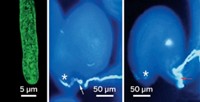Advertisement
Grab your lab coat. Let's get started
Welcome!
Welcome!
Create an account below to get 6 C&EN articles per month, receive newsletters and more - all free.
It seems this is your first time logging in online. Please enter the following information to continue.
As an ACS member you automatically get access to this site. All we need is few more details to create your reading experience.
Not you? Sign in with a different account.
Not you? Sign in with a different account.
ERROR 1
ERROR 1
ERROR 2
ERROR 2
ERROR 2
ERROR 2
ERROR 2
Password and Confirm password must match.
If you have an ACS member number, please enter it here so we can link this account to your membership. (optional)
ERROR 2
ACS values your privacy. By submitting your information, you are gaining access to C&EN and subscribing to our weekly newsletter. We use the information you provide to make your reading experience better, and we will never sell your data to third party members.
Chemical Communication
Parasite eavesdrops on host to reproduce
Dodder plants wait for host’s signal before producing flowers
by Ariana Remmel
September 4, 2020
| A version of this story appeared in
Volume 98, Issue 34
Most plants produce flowers when their leaves detect environmental cues that indicate the time is right. Parasitic dodder plants cheat. These plants don’t have leaves or roots of their own. Instead, they siphon nutrients from a host plant by grafting themselves to its vasculature. A team of researchers led by Jianqiang Wu, a botanist and chemical ecologist at the Chinese Academy of Sciences, has now shown that a species of dodder called Cuscuta australis eavesdrops on its host’s protein messengers to know when to produce flowers (Proc. Natl. Acad. Sci. USA 2020, DOI: 10.1073/pnas.2009445117). They found that C. australis relies on a host-produced protein called flowering locus T (FT) that’s made in the leaves when the host is ready to flower. As FT is transported through the host, C. australis absorbs the protein to induce flower generation of its own. This allows the dodder parasite to synchronize its flowering period with a wide variety of hosts, because FT is produced by many species. Further, genetic analysis shows that the C. australis genome has lost the ability to produce its own FT. “The dodder plant gave up its own flowering mechanism in order to gain ecological benefit,” namely adjusting its life cycle with respect to its host, Wu says. The team is investigating whether a similar communication strategy is used by other plant parasites that plague crops.





Join the conversation
Contact the reporter
Submit a Letter to the Editor for publication
Engage with us on Twitter